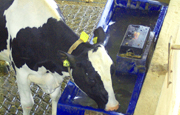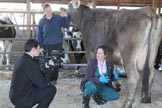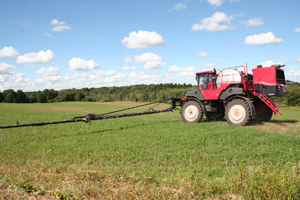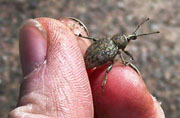
Chazy, NY; January 10, 2017. Water quality is critical to maintain healthy, productive dairy cows. Eighteen farms in the Northern New York region participated in research funded by the farmer-driven Northern New York Agricultural Development Program evaluating the impact of water quality on fiber digestion by dairy cows.
Researchers with the W.H. Miner Agricultural Research Institute in Chazy, NY, sampled and analyzed water from participating farms for such factors as minerals, pH, hardness, sulfates, nitrates, and bacteria.
“To evaluate how water quality, specifically levels of mineral, nitrate, or bacteria, affects dairy cow fiber digestion, the water samples were used to conduct fiber digestion analyses of a variety of forages, including corn silages, alfalfa hay, grass silage, and wheat straw,” says Miner Institute Forage Lab Director Kurt Cotanch.
Previous research conducted in South Dakota has indicated that low water quality, defined as water having mineral, bacterial or other compound levels above a prescribed ‘normal’ range, could decrease fiber digestion.
Other research has shown that high concentrations of sulfur or iron can produce unpleasant taste or odor that may cause cows to decrease water intake and that may result in decreased milk production.
None of the water samples collected for the Northern New York project were identified as being of poor quality, Cotanch says.
The results of the fiber digestion analyses in Northern New York indicated a slight positive correlation between sodium and nitrate levels and fiber digestion; a slight negative correlation was found with magnesium and potassium. For example, the digestibility of conventional corn silage was significantly reduced as magnesium levels in water samples increased, while an increase in sodium level showed a moderate increase in the fiber digestibility of some forages, including grass silage.
“Water quality deserves consideration for the nutrients the water can provide in dairy ration formulation, and for potential negative nutritional and palatability factors that could inhibit water consumption. How water quality affects fiber digestion is an area for further exploration,” Cotanch notes.
The report titled ‘Do High Mineral Concentrations in Water Affect Fiber Digestibility, Cow Health and Performance on Northern New York Dairy Farms’ is posted on the Northern New York Agricultural Development Program website at nnyagdev.org.
The farmer-driven Northern New York Agricultural Development Program provides research and technical assistance to farmers in Clinton, Essex, Franklin, Jefferson, Lewis and St. Lawrence counties.
Funding for the Northern New York Agricultural Development Program is supported by the New York State Senate and administered through the New York State Department of Agriculture and Markets.
 Veterinarian Jessica Scillieri Smith, right, of Quality Milk Production Services, talks with a tv reporter at Hy-Light Farms, one of 143 NNY farms participating in the farmer-driven Northern New York Agricultural Development Program-funded project identifying lesser-known causes of mastitis. Holding the Brown Swiss cow is farm co-owner Heather Hyman. Photo: Kara Lynn Dunn
Veterinarian Jessica Scillieri Smith, right, of Quality Milk Production Services, talks with a tv reporter at Hy-Light Farms, one of 143 NNY farms participating in the farmer-driven Northern New York Agricultural Development Program-funded project identifying lesser-known causes of mastitis. Holding the Brown Swiss cow is farm co-owner Heather Hyman. Photo: Kara Lynn Dunn

 “This new agri-business development by a young entrepreneur is an added benefit to our regional economy and we are pleased it was sparked by the science developed with Northern New York Agricultural Development Program funding,” said Jon Greenwood, co-Chair of the farmer-driven research and technical assistance program serving Clinton, Essex, Franklin, Jefferson, Lewis and St. Lawrence counties.
“This new agri-business development by a young entrepreneur is an added benefit to our regional economy and we are pleased it was sparked by the science developed with Northern New York Agricultural Development Program funding,” said Jon Greenwood, co-Chair of the farmer-driven research and technical assistance program serving Clinton, Essex, Franklin, Jefferson, Lewis and St. Lawrence counties. “Scouting vigilance and proactive application of the biocontrol nematodes are key to limiting the spread and impact of alfalfa snout beetle,” Shields notes.”
“Scouting vigilance and proactive application of the biocontrol nematodes are key to limiting the spread and impact of alfalfa snout beetle,” Shields notes.”